
Spitz
Encyclopedia
Spitz-type dog
s (the correct German
plural is Spitze, though Spitzen is commonly used in the United States) are a type
of dog, characterized by long, thick, and often white fur, and pointed ears and muzzles. The tail is usually curled over the dog's back.
or East Asian regions. The type was described as Canis pomeranus by Johann Friedrich Gmelin
in his revision of Systema naturae
in 1788 (printed in English in 1792.)
There is no archaeological
evidence showing transition stages between the wolf and the often-similar Spitz-type dogs. Skeletal remains up to 5,000 years old suggest it is far more likely that the ancestor
s of Spitz types mated
with wolves. In recent genetic testing of dog breeds, many Spitz-types were found to be in the group closest to wolves, presumed to be the oldest types of dogs.
Humans have intentionally mated Spitz-types with wolves in more recent times to achieve or maintain the wolf-like appearance of breeds such as the Alaskan Malamute
.
, North America
, Asia
, and to a lesser extent, Africa
.
Skeletal remains around 2,000 years old unearthed in Switzerland
indicate that Spitz-type dogs have inhabited Central Europe
for millennia. These dogs are almost certainly the ancestors of the European Spitz-types, such as the German Spitz
and Schipperke
.
Many Spitz-types also migrated into Siberia
and Mongolia
. Over the centuries, many of these dogs were transported by humans to Japan
, most likely from Manchuria
. These Asian Spitz types are the ancestors of today's breeds such as the Chow Chow
and the Akita Inu.
, Spitz types have been developed to fit three purposes helping humans: hunting
, herding
, and pulling sleds
.
The larger and more powerful breeds such as the Akita Inu, Karelian Bear Dog
, Norwegian Elkhound
and Swedish Elkhound were used for big game
hunting
, helping humans kill moose
and brown bear
s.
Smaller breeds such as the Finnish Spitz
and the Lundehund were used in Scandinavia
to hunt birds and smaller mammals.
Two of the very largest Spitz types, notably the Canadian Eskimo Dog
and the Greenland Dog
, were used to pull sleds up until the 19th century. During that century, when fur trapping became a lucrative business, people began to realize that size did not necessarily relate with endurance, and the smaller Siberian Husky
came to be used more frequently in Canada
and Alaska
. The Finnish Lapphund
was used by the Sami people
.
, waterproof undercoat
that is denser than the topcoat to trap warmth.
Small ears help reduce the risk of frostbite
, and thick fur that grows on the paws protects the dogs from sharp ice.
Many Spitz-type breeds retain wolf-like characteristics such as independence, suspiciousness, and aggression towards unfamiliar humans or other dogs, and can therefore require much training before they become manageable. Some, such as the Karelian Bear Dog
, are almost impossible to train as companion dog
s. Spitz dogs have been said to be more prone to hydrophobia
.
or lap dog
s. This trend is most evident in the tiny Pomeranian
, which was originally a much larger dog closer to the size of a Keeshond
before being bred down to make an acceptable court animal. The Keeshond, the Wolfsspitz variation of the German Spitz
, widely known as the national dog of the Netherlands
, is an affectionate and loyal, albeit very energetic, pet.
Other Spitz types which have been bred away from working uses are the American Eskimo Dog
, the Alaskan Klee Kai
, the German Spitz, the Japanese Spitz
, and the Pomeranian
.
, exhibit the tail, coat, and head of a Spitz dog, but its ears more closely resemble those of spaniel
s although being upright like the Spitz. In the future, genetic studies might better clarify the relationship among various breeds. Note that dogs listed here might also be classified as toy dog
s, herding dog
s, sled dog
s, and in other types.
Dog
The domestic dog is a domesticated form of the gray wolf, a member of the Canidae family of the order Carnivora. The term is used for both feral and pet varieties. The dog may have been the first animal to be domesticated, and has been the most widely kept working, hunting, and companion animal in...
s (the correct German
German language
German is a West Germanic language, related to and classified alongside English and Dutch. With an estimated 90 – 98 million native speakers, German is one of the world's major languages and is the most widely-spoken first language in the European Union....
plural is Spitze, though Spitzen is commonly used in the United States) are a type
Dog type
Dog types are broad categories of dogs based on function, with dogs identified primarily by specific function or style of work rather than by lineage or appearance....
of dog, characterized by long, thick, and often white fur, and pointed ears and muzzles. The tail is usually curled over the dog's back.
Origins
The exact origins of Spitz-type dogs are not known, though most of the Spitz-types seen today originate from the ArcticArctic
The Arctic is a region located at the northern-most part of the Earth. The Arctic consists of the Arctic Ocean and parts of Canada, Russia, Greenland, the United States, Norway, Sweden, Finland, and Iceland. The Arctic region consists of a vast, ice-covered ocean, surrounded by treeless permafrost...
or East Asian regions. The type was described as Canis pomeranus by Johann Friedrich Gmelin
Johann Friedrich Gmelin
Johann Friedrich Gmelin was a German naturalist, botanist, entomologist, herpetologist and malacologist.- Education :Johann Friedrich Gmelin was born as the eldest son of Philipp Friedrich Gmelin in 1748 in Tübingen...
in his revision of Systema naturae
Systema Naturae
The book was one of the major works of the Swedish botanist, zoologist and physician Carolus Linnaeus. The first edition was published in 1735...
in 1788 (printed in English in 1792.)
There is no archaeological
Archaeology
Archaeology, or archeology , is the study of human society, primarily through the recovery and analysis of the material culture and environmental data that they have left behind, which includes artifacts, architecture, biofacts and cultural landscapes...
evidence showing transition stages between the wolf and the often-similar Spitz-type dogs. Skeletal remains up to 5,000 years old suggest it is far more likely that the ancestor
Ancestor
An ancestor is a parent or the parent of an ancestor ....
s of Spitz types mated
Mating
In biology, mating is the pairing of opposite-sex or hermaphroditic organisms for copulation. In social animals, it also includes the raising of their offspring. Copulation is the union of the sex organs of two sexually reproducing animals for insemination and subsequent internal fertilization...
with wolves. In recent genetic testing of dog breeds, many Spitz-types were found to be in the group closest to wolves, presumed to be the oldest types of dogs.
Humans have intentionally mated Spitz-types with wolves in more recent times to achieve or maintain the wolf-like appearance of breeds such as the Alaskan Malamute
Alaskan Malamute
The Alaskan Malamute is a generally large breed of domestic dog originally bred for use as a utilitarian dog and later an Alaskan sled dog. They are sometimes mistaken for a Siberian Husky, but in fact are quite different in many ways...
.
Migrations
About 3,000 years ago, dogs began to migrate from the Arctic into temperate EuropeEurope
Europe is, by convention, one of the world's seven continents. Comprising the westernmost peninsula of Eurasia, Europe is generally 'divided' from Asia to its east by the watershed divides of the Ural and Caucasus Mountains, the Ural River, the Caspian and Black Seas, and the waterways connecting...
, North America
North America
North America is a continent wholly within the Northern Hemisphere and almost wholly within the Western Hemisphere. It is also considered a northern subcontinent of the Americas...
, Asia
Asia
Asia is the world's largest and most populous continent, located primarily in the eastern and northern hemispheres. It covers 8.7% of the Earth's total surface area and with approximately 3.879 billion people, it hosts 60% of the world's current human population...
, and to a lesser extent, Africa
Africa
Africa is the world's second largest and second most populous continent, after Asia. At about 30.2 million km² including adjacent islands, it covers 6% of the Earth's total surface area and 20.4% of the total land area...
.
Skeletal remains around 2,000 years old unearthed in Switzerland
Switzerland
Switzerland name of one of the Swiss cantons. ; ; ; or ), in its full name the Swiss Confederation , is a federal republic consisting of 26 cantons, with Bern as the seat of the federal authorities. The country is situated in Western Europe,Or Central Europe depending on the definition....
indicate that Spitz-type dogs have inhabited Central Europe
Central Europe
Central Europe or alternatively Middle Europe is a region of the European continent lying between the variously defined areas of Eastern and Western Europe...
for millennia. These dogs are almost certainly the ancestors of the European Spitz-types, such as the German Spitz
German Spitz
German Spitz is used to refer to both a breed of dog and category or type of dog. Several modern breeds have been developed from the German Spitz, and are either registered as separate breeds or as varieties of German Spitz. All the German Spitz type dogs are dogs of the Spitz type of German origin...
and Schipperke
Schipperke
A Schipperke is a small Belgian breed of dog that originated in the early 16th century. There has been a long informal debate over whether this type of dog is a spitz or miniature sheepdog.- Description :...
.
Many Spitz-types also migrated into Siberia
Siberia
Siberia is an extensive region constituting almost all of Northern Asia. Comprising the central and eastern portion of the Russian Federation, it was part of the Soviet Union from its beginning, as its predecessor states, the Tsardom of Russia and the Russian Empire, conquered it during the 16th...
and Mongolia
Mongolia
Mongolia is a landlocked country in East and Central Asia. It is bordered by Russia to the north and China to the south, east and west. Although Mongolia does not share a border with Kazakhstan, its western-most point is only from Kazakhstan's eastern tip. Ulan Bator, the capital and largest...
. Over the centuries, many of these dogs were transported by humans to Japan
Japan
Japan is an island nation in East Asia. Located in the Pacific Ocean, it lies to the east of the Sea of Japan, China, North Korea, South Korea and Russia, stretching from the Sea of Okhotsk in the north to the East China Sea and Taiwan in the south...
, most likely from Manchuria
Manchuria
Manchuria is a historical name given to a large geographic region in northeast Asia. Depending on the definition of its extent, Manchuria usually falls entirely within the People's Republic of China, or is sometimes divided between China and Russia. The region is commonly referred to as Northeast...
. These Asian Spitz types are the ancestors of today's breeds such as the Chow Chow
Chow Chow
Chow chow is a breed of dog that was developed in China, where it is referred to as Songshi Quan , which literally means "puffy-lion dog".- Appearance :...
and the Akita Inu.
Working dogs
Through selective breedingSelective breeding
Selective breeding is the process of breeding plants and animals for particular genetic traits. Typically, strains that are selectively bred are domesticated, and the breeding is sometimes done by a professional breeder. Bred animals are known as breeds, while bred plants are known as varieties,...
, Spitz types have been developed to fit three purposes helping humans: hunting
Hunting dog
A hunting dog refers to any dog who assists humans in hunting. There are several types of hunting dogs developed for various tasks. The major categories of hunting dogs include hounds, terriers, dachshunds, cur type dogs, and gun dogs...
, herding
Herding dog
A herding dog, also known as a stock dog or working dog, is a type of pastoral dog that either has been trained in herding or belongs to breeds developed for herding...
, and pulling sleds
Sled dog
Sled dogs, known also as sleigh man dogs, sledge dogs, or sleddogs, are highly trained types of dogs that are used to pull a dog sled, a wheel-less vehicle on runners also called a sled or sleigh, over snow or ice, by means of harnesses and lines.Sled dogs have become a popular winter recreation...
.
The larger and more powerful breeds such as the Akita Inu, Karelian Bear Dog
Karelian Bear Dog
The Karelian Bear Dog is a Finnish or Karelian breed of dog. In its home country, it is regarded as a national treasure. KBD will hunt any kind of animal. Its quick reflexes and fearless nature have made it very popular for hunting aggressive game, including bear, moose, and wild boar...
, Norwegian Elkhound
Norwegian Elkhound
The Norwegian Elkhound is one of the ancient Northern Spitz-type breed of dog and is the National Dog of Norway. The Elkhound has served as a hunter, guardian, herder, and defender. In a land of subzero temperatures, deep snow, thick forests, and rugged mountains, only the hardiest of the breeds...
and Swedish Elkhound were used for big game
Game (food)
Game is any animal hunted for food or not normally domesticated. Game animals are also hunted for sport.The type and range of animals hunted for food varies in different parts of the world. This will be influenced by climate, animal diversity, local taste and locally accepted view about what can or...
hunting
Hunting
Hunting is the practice of pursuing any living thing, usually wildlife, for food, recreation, or trade. In present-day use, the term refers to lawful hunting, as distinguished from poaching, which is the killing, trapping or capture of the hunted species contrary to applicable law...
, helping humans kill moose
Moose
The moose or Eurasian elk is the largest extant species in the deer family. Moose are distinguished by the palmate antlers of the males; other members of the family have antlers with a dendritic configuration...
and brown bear
Brown Bear
The brown bear is a large bear distributed across much of northern Eurasia and North America. It can weigh from and its largest subspecies, the Kodiak Bear, rivals the polar bear as the largest member of the bear family and as the largest land-based predator.There are several recognized...
s.
Smaller breeds such as the Finnish Spitz
Finnish Spitz
A Finnish Spitz is a breed of dog originating in Finland. The breed was originally bred to hunt all types of game from squirrels and other rodents to bears. It is a "bark pointer", indicating the position of game by barking to attract the hunter's attention...
and the Lundehund were used in Scandinavia
Scandinavia
Scandinavia is a cultural, historical and ethno-linguistic region in northern Europe that includes the three kingdoms of Denmark, Norway and Sweden, characterized by their common ethno-cultural heritage and language. Modern Norway and Sweden proper are situated on the Scandinavian Peninsula,...
to hunt birds and smaller mammals.
Two of the very largest Spitz types, notably the Canadian Eskimo Dog
Canadian Eskimo Dog
The Canadian Eskimo Dog is an Arctic breed of dog , which is often considered to be North America’s oldest and rarest remaining purebred indigenous domestic canine. Other names include Qimmiq...
and the Greenland Dog
Greenland Dog
The Greenland Dog is a large breed of husky-type dog kept as a sled dog and for hunting polar bear and seal. This is an ancient breed, thought to be directly descended from dogs brought to Greenland by the first Inuit settlers.-Appearance:The Greenland Dog is a powerful, heavy-built dog...
, were used to pull sleds up until the 19th century. During that century, when fur trapping became a lucrative business, people began to realize that size did not necessarily relate with endurance, and the smaller Siberian Husky
Siberian Husky
The Siberian Husky is a medium-size, dense-coat working dog breed that originated in north-eastern Siberia. The breed belongs to the Spitz genetic family...
came to be used more frequently in Canada
Canada
Canada is a North American country consisting of ten provinces and three territories. Located in the northern part of the continent, it extends from the Atlantic Ocean in the east to the Pacific Ocean in the west, and northward into the Arctic Ocean...
and Alaska
Alaska
Alaska is the largest state in the United States by area. It is situated in the northwest extremity of the North American continent, with Canada to the east, the Arctic Ocean to the north, and the Pacific Ocean to the west and south, with Russia further west across the Bering Strait...
. The Finnish Lapphund
Finnish Lapphund
The Finnish Lapphund is a hardy, easy going, medium-size breed of Spitz type. Traditionally it has been used for herding reindeer. Although it is one of the most popular dog breeds in its native country, Finland, it is not very numerous outside of the Nordic countries.-Appearance:-Type:The Finnish...
was used by the Sami people
Sami people
The Sami people, also spelled Sámi, or Saami, are the arctic indigenous people inhabiting Sápmi, which today encompasses parts of far northern Sweden, Norway, Finland, the Kola Peninsula of Russia, and the border area between south and middle Sweden and Norway. The Sámi are Europe’s northernmost...
.
Adaptation to the Arctic
Spitz-types are well suited to living in harsh northern climates. They often have an insulatingThermal insulation
Thermal insulation is the reduction of the effects of the various processes of heat transfer between objects in thermal contact or in range of radiative influence. Heat transfer is the transfer of thermal energy between objects of differing temperature...
, waterproof undercoat
Down hair
Down hairs, also called the ground hairs, are the very fine, fluffy hairs closest to the skin on some mammals. The hairs are short and crimped, which makes them highly efficient for trapping air and insulating the animal....
that is denser than the topcoat to trap warmth.
Small ears help reduce the risk of frostbite
Frostbite
Frostbite is the medical condition where localized damage is caused to skin and other tissues due to extreme cold. Frostbite is most likely to happen in body parts farthest from the heart and those with large exposed areas...
, and thick fur that grows on the paws protects the dogs from sharp ice.
Many Spitz-type breeds retain wolf-like characteristics such as independence, suspiciousness, and aggression towards unfamiliar humans or other dogs, and can therefore require much training before they become manageable. Some, such as the Karelian Bear Dog
Karelian Bear Dog
The Karelian Bear Dog is a Finnish or Karelian breed of dog. In its home country, it is regarded as a national treasure. KBD will hunt any kind of animal. Its quick reflexes and fearless nature have made it very popular for hunting aggressive game, including bear, moose, and wild boar...
, are almost impossible to train as companion dog
Companion dog
Companion dog usually describes a dog that does not work, providing only companionship as a pet, rather than usefulness by doing specific tasks. Many of the toy dog breeds are used only for the pleasure of their company, not as workers...
s. Spitz dogs have been said to be more prone to hydrophobia
Rabies
Rabies is a viral disease that causes acute encephalitis in warm-blooded animals. It is zoonotic , most commonly by a bite from an infected animal. For a human, rabies is almost invariably fatal if post-exposure prophylaxis is not administered prior to the onset of severe symptoms...
.
Companions and toys
The charming look of the Spitz-type, with its thick fur, fluffy ruff, curled tail and small muzzle and ears, has caused several people to create non-working types designed to be companionsCompanion dog
Companion dog usually describes a dog that does not work, providing only companionship as a pet, rather than usefulness by doing specific tasks. Many of the toy dog breeds are used only for the pleasure of their company, not as workers...
or lap dog
Lap dog
A lapdog or lap dog is a dog that is small enough to be held in the arms or lie comfortably on a person's lap. Lapdogs are not a specific breed, but is a generic term for a type of dog of small size and friendly disposition....
s. This trend is most evident in the tiny Pomeranian
Pomeranian (dog)
The Pomeranian is a breed of dog of the Spitz type, named for the Pomerania region in Central Europe . Classed as a toy dog breed because of its small size, the Pomeranian is descended from the larger Spitz type dogs, specifically the German Spitz...
, which was originally a much larger dog closer to the size of a Keeshond
Keeshond
The Keeshond is a medium-sized dog with a plush two-layer coat of silver and black fur with a 'ruff' and a curled tail. It originated in Germany, and its closest relatives are the other German spitzes such as the Pomeranian...
before being bred down to make an acceptable court animal. The Keeshond, the Wolfsspitz variation of the German Spitz
German Spitz
German Spitz is used to refer to both a breed of dog and category or type of dog. Several modern breeds have been developed from the German Spitz, and are either registered as separate breeds or as varieties of German Spitz. All the German Spitz type dogs are dogs of the Spitz type of German origin...
, widely known as the national dog of the Netherlands
Netherlands
The Netherlands is a constituent country of the Kingdom of the Netherlands, located mainly in North-West Europe and with several islands in the Caribbean. Mainland Netherlands borders the North Sea to the north and west, Belgium to the south, and Germany to the east, and shares maritime borders...
, is an affectionate and loyal, albeit very energetic, pet.
Other Spitz types which have been bred away from working uses are the American Eskimo Dog
American Eskimo Dog
The American Eskimo Dog is a breed of companion dog originating in Germany. The American Eskimo is a member of the Spitz family. Despite its name and appearance, the American Eskimo dog is not from Alaska; the dog's heritage is traced back to Northern Europe...
, the Alaskan Klee Kai
Alaskan Klee Kai
The Alaskan Klee Kai is a northern breed of dog of spitz type. The term "Klee Kai" was derived from Alaskan Athabaskan words meaning "small dog"...
, the German Spitz, the Japanese Spitz
Japanese Spitz
The is a small to medium breed of dog of the Spitz type. The Japanese Spitz is a companion dog and pet. There are varying standards around the world as to the ideal size of the breed, but they are always larger than their smaller cousins, the Pomeranian. They were developed in Japan in the 1920s...
, and the Pomeranian
Pomeranian (dog)
The Pomeranian is a breed of dog of the Spitz type, named for the Pomerania region in Central Europe . Classed as a toy dog breed because of its small size, the Pomeranian is descended from the larger Spitz type dogs, specifically the German Spitz...
.
Dog breeds
This list might not be complete and is, at best, an educated guess from experts and dog fanciers based on the physical characteristics of the breeds. Some, such as the PapillonPapillon (dog)
The papillon , also called the Continental Toy Spaniel, is a breed of dog of the Spaniel type. One of the oldest of the toy Spaniels, it derives its name from its characteristic butterfly-like look of the long and fringed hair on the ears. A papillon with dropped ears is called a phalène...
, exhibit the tail, coat, and head of a Spitz dog, but its ears more closely resemble those of spaniel
Spaniel
A spaniel is a type of gun dog. It is assumed spaniels originated from Spain as the word spaniel may be derived from Hispania or possibly from the French phrase "Chiens de l’Espagnol" . Spaniels were especially bred to flush game out of dense brush. By the late 17th century spaniels had become...
s although being upright like the Spitz. In the future, genetic studies might better clarify the relationship among various breeds. Note that dogs listed here might also be classified as toy dog
Toy dog
Toy dog traditionally refers to a very small dog or a grouping of small and very small breeds of dog. A toy dog may be of any of various dog types. Types of dogs referred to as toy dogs may include Spaniels, Pinschers and Terriers that have been bred down in size. Not all toy dogs are lapdogs,...
s, herding dog
Herding dog
A herding dog, also known as a stock dog or working dog, is a type of pastoral dog that either has been trained in herding or belongs to breeds developed for herding...
s, sled dog
Sled dog
Sled dogs, known also as sleigh man dogs, sledge dogs, or sleddogs, are highly trained types of dogs that are used to pull a dog sled, a wheel-less vehicle on runners also called a sled or sleigh, over snow or ice, by means of harnesses and lines.Sled dogs have become a popular winter recreation...
s, and in other types.
| Akita Inu |  |
| Alaskan Husky Alaskan Husky The Alaskan husky is not a breed of dog rather it is a type or a category. It falls short of being a breed in that there is no preferred type of and no restriction as to ancestry; it is defined only by its purpose, which is that of a highly efficient sled dog... |
 |
| Alaskan Klee Kai Alaskan Klee Kai The Alaskan Klee Kai is a northern breed of dog of spitz type. The term "Klee Kai" was derived from Alaskan Athabaskan words meaning "small dog"... |
 |
| Alaskan Malamute Alaskan Malamute The Alaskan Malamute is a generally large breed of domestic dog originally bred for use as a utilitarian dog and later an Alaskan sled dog. They are sometimes mistaken for a Siberian Husky, but in fact are quite different in many ways... |
 |
| American Akita American Akita The Akita is a large spitz breed of dog originating from the mountainous northern regions of Japan. There are now two separate strains: American, a/k/a "Akita" or "American Akita"; and Japanese, aka "Akita Inu" or "Japanese Akita"... |
 |
| American Eskimo Dog American Eskimo Dog The American Eskimo Dog is a breed of companion dog originating in Germany. The American Eskimo is a member of the Spitz family. Despite its name and appearance, the American Eskimo dog is not from Alaska; the dog's heritage is traced back to Northern Europe... |
 |
| Black Norwegian Elkhound Black Norwegian Elkhound The Black Norwegian Elkhound is a modern variant of the Grey Norwegian Elkhound. It is a small Spitz breed and is very rare outside the Nordic countries of Scandinavia. It is bred for the same purpose as the Grey Norwegian Elkhound but is smaller, more agile, and easier to recognize in the snow... |
 |
| Canaan Dog Canaan Dog The Canaan dog is a Canaanite breed of dog which may have existed in the eastern Mediterranean seaboard for millennia, as referenced in ancient sculptures.-Appearance:... |
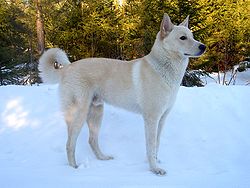 |
| Canadian Eskimo Dog Canadian Eskimo Dog The Canadian Eskimo Dog is an Arctic breed of dog , which is often considered to be North America’s oldest and rarest remaining purebred indigenous domestic canine. Other names include Qimmiq... |
 |
| Chow Chow Chow Chow Chow chow is a breed of dog that was developed in China, where it is referred to as Songshi Quan , which literally means "puffy-lion dog".- Appearance :... |
 |
| East Siberian Laika East Siberian Laika The East Siberian Laika is a Russian breed of dog of spitz type, a hunting dog originating in parts of Siberia east of the Yenisei River.- Appearance :Males are , while females are on the smaller side at .... |
 |
| Eurasier Eurasier The Eurasier, sometimes referred to as Eurasian, is a breed of dog of spitz type that originated in Germany. It is widely known as a wonderful companion that maintains its own personality, has a dignified reserve to strangers, a strong bond to its family and that is relatively easy to... |
 |
| Finnish Lapphund Finnish Lapphund The Finnish Lapphund is a hardy, easy going, medium-size breed of Spitz type. Traditionally it has been used for herding reindeer. Although it is one of the most popular dog breeds in its native country, Finland, it is not very numerous outside of the Nordic countries.-Appearance:-Type:The Finnish... |
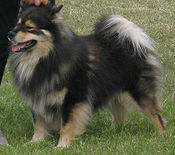 |
| Finnish Spitz Finnish Spitz A Finnish Spitz is a breed of dog originating in Finland. The breed was originally bred to hunt all types of game from squirrels and other rodents to bears. It is a "bark pointer", indicating the position of game by barking to attract the hunter's attention... |
 |
| German Spitz German Spitz German Spitz is used to refer to both a breed of dog and category or type of dog. Several modern breeds have been developed from the German Spitz, and are either registered as separate breeds or as varieties of German Spitz. All the German Spitz type dogs are dogs of the Spitz type of German origin... |
 |
| Greenland Dog Greenland Dog The Greenland Dog is a large breed of husky-type dog kept as a sled dog and for hunting polar bear and seal. This is an ancient breed, thought to be directly descended from dogs brought to Greenland by the first Inuit settlers.-Appearance:The Greenland Dog is a powerful, heavy-built dog... |
 |
| Guejae Gae Guejae Gae The Guejae Gae is a type of dog similar to the Korean Jindo Dog. While these dogs are almost identical, the Guejae is slightly larger with longer canine teeth that bend slightly inward.... |
|
| Hokkaidō Hokkaido (dog) The is a breed of dog. Other names for the breed include Ainu-ken and Seta. In Japan, its name is sometimes shortened to Dō-ken. The Hokkaido is native to the prefecture of the same name in Japan.-Appearance:... |
 |
| Icelandic Sheepdog Icelandic Sheepdog The Icelandic sheepdog is a breed of dog of spitz type originating from the dogs brought to Iceland by the Vikings. It is of similar type to the Norwegian Buhund and to the ancestor of the modern Shetland sheepdog and Welsh corgi. They are still commonly used to herd sheep in the Icelandic... |
 |
| Indian Spitz Indian Spitz The Indian Spitz is a spitz-type dog breed belonging to the Utility Dog group. It is very similar to the German Spitz in appearance but is roughly 1.5-2.5 inches shorter at the withers and weighs around 10-15 Lbs less.... |
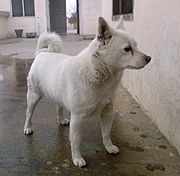 |
| Jämthund Jämthund The Jämthund, also called the Swedish Elkhound, is a breed of dog of the Spitz type that are found in Northern Europe. The Jämthund is eponymous to Jämtland, a province in the middle of Sweden. The dog is described as having a wolf-like appearance.... |
 |
| Japanese Spitz Japanese Spitz The is a small to medium breed of dog of the Spitz type. The Japanese Spitz is a companion dog and pet. There are varying standards around the world as to the ideal size of the breed, but they are always larger than their smaller cousins, the Pomeranian. They were developed in Japan in the 1920s... |
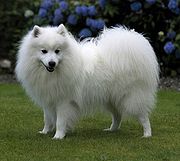 |
| Kai Ken Kai Ken The is a breed of dog that hails from Japan where it is a natural monument and has been bred for centuries. It is an extremely rare dog even in its native land and is related to the Japanese Spitz dog type.-Appearance:... |
 |
| Karelian Bear Dog Karelian Bear Dog The Karelian Bear Dog is a Finnish or Karelian breed of dog. In its home country, it is regarded as a national treasure. KBD will hunt any kind of animal. Its quick reflexes and fearless nature have made it very popular for hunting aggressive game, including bear, moose, and wild boar... |
 |
| Keeshond Keeshond The Keeshond is a medium-sized dog with a plush two-layer coat of silver and black fur with a 'ruff' and a curled tail. It originated in Germany, and its closest relatives are the other German spitzes such as the Pomeranian... |
 |
| Kintamani Kintamani (dog) The Kintamani is a dog native to the Indonesian island of Bali. It is a popular pet for the Balinese and locally Bali's only official breed and efforts are currently under way to have the dog accepted by the Federation Cynologique Internationale as a recognized breed... |
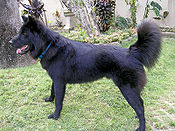 |
| Kishu Kishu The , sometimes called Kishu Ken or Kishu Inu, is a Japanese breed of dog, developed there for thousands of years. It is descended from ancient medium-sized breeds and named after the Kishu region, now Wakayama Prefecture. This breed is similar to the Akita Inu and the Shiba Inu but predates both... |
 |
| Korean Jindo Dog |  |
| Labrador Husky Labrador Husky The Labrador Husky is a spitz type of dog that was bred for work as a very strong, fast sled dog; it is a purebred originating from Canada. Although the breed's name may be baffling, it is not a mix between a Labrador Retriever and a Husky... |
|
| Lapponian Herder Lapponian herder The Lapponian herder is a breed of dog from Finland, one of three Lapphund breeds developed from a type of dog used by the Sami people for herding and guarding their reindeer.... |
 |
| Mackenzie River Husky Mackenzie River Husky The term Mackenzie River Husky describes several overlapping local populations of arctic and subarctic sleddog type dogs, none of which constitutes a breed. Most prominent and current of these are the sleddogs of Donna Dowling and others in the interior of Alaska. These dogs are described as... |
 |
| Norrbottenspets Norrbottenspets The Norbottenspets is a breed of dog of the spitz type. It is an ancient breed whose original purpose was a farm and hunting dog but has recently became more popular as a companion dog. The Norrbottenspets is used to hunt wood grouse, black grouse, capercaillie and hazel grouse, but also fox,... |
 |
| Northern Inuit Dog Northern Inuit Dog The Northern Inuit Dog is a breed originating in the late 1980s, in an attempt to create a domestic dog breed more closely resembling the wolf.-Appearance:... |
|
| Norwegian Buhund Norwegian Buhund The Norwegian Buhund is a breed of dog of the spitz type. It is closely related to the Icelandic Sheepdog and the Jämthund. The name Buhund is derived from the Norwegian word "bu" which means farm, homestead or mountain hut, where the shepherd lived while looking after his herd in the summer... |
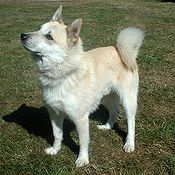 |
| Norwegian Elkhound Norwegian Elkhound The Norwegian Elkhound is one of the ancient Northern Spitz-type breed of dog and is the National Dog of Norway. The Elkhound has served as a hunter, guardian, herder, and defender. In a land of subzero temperatures, deep snow, thick forests, and rugged mountains, only the hardiest of the breeds... |
 |
| Norwegian Lundehund Norwegian Lundehund The Norwegian Lundehund is a small dog breed of the Spitz type that originates from Norway. Its name is composed of the prefix Lunde, from the Norwegian lundefugl , and the suffix hund, meaning dog... |
 |
| Nureongi Nureongi The Nureongi also spelled Noo-rung-yee is a yellowish dog landrace from Korea. It is most often used as a livestock dog, raised for its meat and not commonly kept as a pet.-Terminology:This dog has no formal name... |
|
| Pomeranian Pomeranian (dog) The Pomeranian is a breed of dog of the Spitz type, named for the Pomerania region in Central Europe . Classed as a toy dog breed because of its small size, the Pomeranian is descended from the larger Spitz type dogs, specifically the German Spitz... |
 |
| Pungsan Pungsan Dog The Pungsan or Poongsan is a breed of hunting dog from North Korea. They receive their name from the mountainous northern county of P'ungsan, now Kimhyŏnggwŏn, where they were first bred. They are a very rare dog, and are hardly known outside of North Korea.-Appearance:The Pungsan is a mixed... |
|
| Russo-European Laika Russo-European Laika Russo-European Laika is the name of a breed of hunting dog that originated in the forested region of northern Europe and Russia, one of several breeds developed from landrace Laika dogs of very ancient Spitz type. The Russo-European Laika itself dates to a breeding program begun in 1944 by E. I... |
 |
| Sakhalin Husky Sakhalin Husky The Sakhalin Husky, also known as the , is a breed of dog used as a sled dog.-Appearance:This breed is a spitz type, related to other Japanese dogs such as the Akita Inu... |
|
| Salish Wool Dog Salish Wool Dog The Salish Wool Dog is an extinct breed of white, long-haired, Spitz-type dog that was developed and bred by the native peoples of what is now Washington State and British Columbia.... |
|
| Samoyed Samoyed (dog) The Samoyed dog takes its name from the Samoyedic peoples of Siberia. An alternate name for the breed, especially in Europe, is Bjelkier... |
 |
| Schipperke Schipperke A Schipperke is a small Belgian breed of dog that originated in the early 16th century. There has been a long informal debate over whether this type of dog is a spitz or miniature sheepdog.- Description :... |
|
| Seppala Siberian Sleddog Seppala Siberian Sleddog A rare working dog breed, the Seppala Siberian Sleddog is developed for the purpose of pulling a sled in cold country. It is a moderate-sized dog averaging 40 to 50 pounds weight and 22 or 23 inches height. Colours and markings are considered of little importance; eyes may be brown, blue or any... |
 |
| Shiba Inu Shiba Inu The is the smallest of the six original and distinct breeds of dog from Japan.A small, agile dog that copes very well with mountainous terrain, the Shiba Inu was originally bred for hunting. It is similar in appearance to the Akita, though much smaller in stature... |
 |
| Shikoku Shikoku (dog) The is a native, primitive Japanese breed of dog from Shikoku island that is similar to a Shiba Inu. The Shikoku is not a recognized breed of the American Kennel Club, but it is recognized by the Japanese Kennel Club, an organization recognized by AKC as an official foreign registry... |
 |
| Siberian Husky Siberian Husky The Siberian Husky is a medium-size, dense-coat working dog breed that originated in north-eastern Siberia. The breed belongs to the Spitz genetic family... |
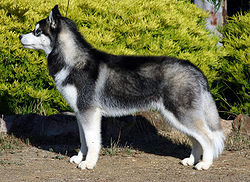 |
| Swedish Lapphund Swedish Lapphund The Swedish Lapphund is a breed of dog of the Spitz type from Sweden, one of three Lapphund breeds developed from a type of dog used by the Sami people for herding and guarding their reindeer.... |
 |
| Swedish Vallhund Swedish Vallhund The Swedish vallhund is a breed of dog. It is believed that the Swedish vallhund distinguished itself during the age of Vikings, more than 1,000 years ago. Known as the "Viking dog", the vallhund were bred to herd cattle, catch vermin , and guard the home... |
 |
| Tamaskan Dog Tamaskan dog The Tamaskan Dog is a rare dog breed of sleddog type, originating from Finland. It is a highly versatile breed that is known to excel in agility, obedience and working trials. It is also capable of pulling sleds, which is inherited from its Siberian Husky and Alaskan Malamute ancestors... |
 |
| Thai Bangkaew Dog Thai Bangkaew Dog The Thai Bangkaew Dog is an Asian dog breed. It is a medium-sized Spitz-type dog.-Appearance:The Thai Bangkaew Dog is compactly built and square in profile. It is well proportioned, with a smooth gait. The double coat consists of a short undercoat, with longer guard hairs growing through it... |
|
| Volpino Italiano Volpino Italiano A Volpino Italiano is a spitz-type breed of dog originally from Italy.-History:Spitz-type dogs were found throughout the ancient world. Specimens from this group have been found preserved in European peat bogs which anthropologists trace to 4000 BC... |
 |
| West Siberian Laika West Siberian Laika The West Siberian Laika, also Zapadno-Sibirskaïa Laïka or WSL, is a breed of hunting dog developed by the indigenous people of Northern Ural and West Siberia... |
 |
| Utonagan Utonagan The Utonagan is a breed of dog that resembles a wolf, but in fact is a mix of three breeds of domestic dog: Alaskan Malamute, German Shepherd, and Siberian Husky.-Appearance:... |

